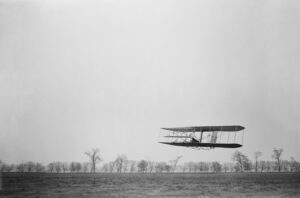Materials engineering is a complex and important field, particularly when it comes to the aerospace industry – and for good reason.
A typical commercial aircraft will have a 30-year cycle, during which time will spend 60,000 hours flying and complete 20,000 flights. It will also spend 100,000 miles of its lifespan by taxiing on the runway – a distance equivalent to 4 times the earth’s circumference. Its total average maintenance and service costs will be double its original purchase price.
In addition, it will be subject to extreme differentials both in terms of pressure and temperature and will have to withstand the impact loads of each landing. It therefore comes as no surprise that so much emphasis is placed on using the correct materials for the right components.
In the beginning…
The next time you fly, take a moment to consider the humble beginnings that led to the advanced technology and comfort of the modern-day aircraft. The Wright Bros’ materials of choice were spruce and ash for the fuselage, combined with fabric to cover the wings and waxed twine to hold it all together. The engines on their first plane were made of cast aluminium for the body and cast iron for the pistons.

Even back then, the Wright Brothers were confronted with similar challenges as today, in finding a good strength to weight ratio (SWR) material that was easy to repair. They found that straight-grained ‘sitka’ spruce had a good SWR compared with other available materials and was relatively easy to fix despite being sensitive to moisture and insect damage.
The introduction of all-metal planes around the time of WW1 was a key development in aviation as the industry strived to develop faster and more robust aircraft. The shift to metal became increasingly popular post WW1 to the mid 1930’s, by which time planes made from wood were practically obsolete.
By the late 1940’s the focus was moving towards high-speed aviation, which led to the development of aluminium alloys and a range of other materials such as titanium alloys, silicon, and ceramics. Since then, the focus has been, and remains on building lighter and more fuel-efficient aircraft.
Modern Day Aerospace
There is no straightforward answer to the question, what are airplanes made of? This depends on the purpose, dimensions, and type of aircraft as well as its multiple component parts. In general, modern-day aerospace, materials must be rigid, strong, tough, corrosion resistant and lightweight.
All of these factors will contribute to the performance of the aircraft over its lifetime as well as its fuel efficiency, which ties into the important factors of affordability and profitability.
Aluminium meets many of the industry’s rigorous criteria and is still the most prevalent material used in aerospace manufacturing – up to 80% in some aircraft. For context, aluminium is approximately a third of the weight of iron or steel. This allows the aircraft to carry more weight for increased fuel efficiency.
The two grades of aluminium most common in aerospace manufacturing are – Alloy 2024 used extensively for aerospace and aircraft components due to its high tensile strength and stress resistance and Alloy 7075 – which is ideal for highly stressed parts such as the fuselage.
Other materials such as titanium alloys, nickel or cobalt based superalloys and composites are utilised in other component parts, but the engine is one of the most complex components of an aircraft and the heat it generates, above 1500 degrees Celsius creates many material challenges.
How does the engine withstand temperatures that would melt most metals?
A jet engine works by fan blades sucking in lots of air from the atmosphere as the plane flies. This air is then compressed and combines with aviation fuel which ignites in the combustion chamber and drives the plane forward. The process results in extreme heated air (up to, and sometimes exceeding 1800c) passing over the turbine blades at the back of the engine.
Currently, even the most heat-resistant aerospace grade metals are not able to withstand those type of extreme temperatures – unless bonded with special ceramics to create ceramic metal composites (CMC’s) – the ceramic providing the heat resistance and the metal the strength. Ceramic is simply too brittle to be used alone.
There are metals in the periodic table with higher melting points than 1500 degrees, but they lack the other vital properties that are equally as important such as strength, toughness, weight etc. Therefore, the fan and compressor blades are titanium, and the turbine blades are superalloys, which tick all the other properties boxes as well as having good conductivity.
As with the engine in your car, the moving parts in an aircraft engine are cooled by oil and there are other systems within the engine design to ensure cooling that may be worth a quick google if you want to learn more.
Total Quality Management
IMET Alloys is proud to be strongly associated with an industry that continually sets the benchmark in innovation and total quality management. There is no room for complacency in the aerospace supply chain and like IMET, suppliers have to be in lockstep with this dynamic sector to thrive and survive.
The advanced processes inherent throughout IMET’s production of secondary raw materials to make titanium and superalloys are driven by technology, innovation, and expertise. It’s what our clients and partners expect from us, and we expect no different from a sector that sets such a high benchmark in engineering excellence and technical performance.
Aircraft materials are not usually the first thing that most people think about when they are about to take a flight, but the next time you do, maybe take a moment to consider the aircraft’s materials and the technology, innovation and expertise that make the seemingly impossible happen.

